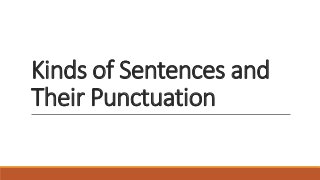
Kinds of Sentences and Their Punctuation 2.pptx
- 1. Kinds of Sentences and Their Punctuation
- 2. A sentence may be one of four kinds, depending upon the number and type(s) of clauses it contains. Review: An independent clause contains a subject, a verb, and a complete thought. Example: I wrote a blog last year. A dependent clause contains a subject and a verb, but no complete thought Example : after I wrote my first novel last year
- 3. Dependent clause Independent clause
- 4. 1.A SIMPLE SENTENCE has one independent clause Tom reads novels Tom reads newspaper Tom reads novels and newspaper (Compound direct object) Tom reads and enjoys novels (Compound verb) Tom and Harry read novels (Compound subject) Tom and Harry read read and enjoy novels and newspapers(Compound subject , verb ,direct object) Note NO commas separate two compound elements (subject, verb, direct object, indirect object, subjective complement, etc.) in a simple sentence
- 5. 2. A COMPOUND SENTENCE has two independent clauses joined by A. a coordinating conjunction (for, and, nor, but, or, yet, so), B. a conjunctive adverb (e.g. however, therefore), or C. a semicolon alone. Examples : To match A ,B , and C above A.Tom reads novels ,but Jack reads comics. B. Tom reads novels ; however ,Jack reads comics C.Tom reads novels ; his friends reads comics. Punctuation patterns (to match A, B, and C above): A. Independent clause, coordinating conjunction independent clause. B. Independent clause; conjunctive adverb, independent clause. C. Independent clause; independent clause
- 7. The FANBOYS The fanboys operate under two basic rules: (1) when the fanboys connect two ideas that could each be a sentence on its own, then we put a comma in front of the fanboys (2) when the fanboys do not connect two ideas that could each be a sentence, then we do not put a comma in front of the fanboys. The fanboys consist of seven words: for, and, nor, but, or, yet, so. Using these seven words in a sentence can connect independent clauses that could each be a sentence on its own. With fanboys, the writer can show readers how the ideas in the two clauses relate to one another
- 9. Conjunctive Adverbs Conjunctive adverbs are adverbs that are used to either tie two independent clauses together or interrupt a single main clause. By using conjunctive adverbs, one can allow for the smooth transition from one idea to another, even if these ideas conflict. They explain the connection that these ideas have to each other: whether or not they work together, conflict, occur simultaneously or occur one after the other in a specific sequence of events may determine which conjunctive adverb will properly convey the sentence’s meaning. Punctuation pattern . Independent clause; conjunctive adverb, independent clause.
- 12. 3. A COMPLEX SENTENCE has one dependent clause (headed by a subordinating conjunction or a relative pronoun ) joined to an independent clause. Examples : A . Although Tom reads novels ,Jack reads comics . B. Jack read comics although Tom reads novels . C. Jack Smith ,who reads comics ,rarely reads novels D. People who read comics rarely read novels . Punctuation patterns (to match A, B, C and D above): A. Dependent clause, independent clause B. Independent clause dependent clause C. Independent, nonessential dependent clause, clause. D. Independent essential dependent clause clause.
- 13. subordinate conjunction The Wabbits The wabbits include when ,where ,while ,after ,although ,before ,because ,if , though , and since. These are a sample of subordinate conjunction
- 23. 4. A COMPOUND-COMPLEX SENTENCE has two independent clauses joined to one or more dependent clauses.
- 24. Source: Open source /Google